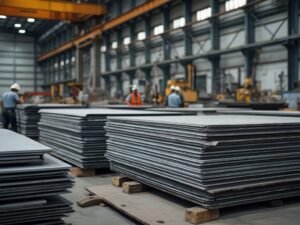What Are the Standard Sizes of Stainless Steel Sheets?

In my years managing stainless steel production, I've noticed that understanding standard sheet sizes is often a major challenge for buyers. Selecting incorrect dimensions can result in material waste and unnecessary costs.
Standard stainless steel sheets typically come in sizes ranging from 1000x2000mm to 1500x6000mm1, with custom sizes available. These dimensions are optimized for manufacturing efficiency, transportation requirements, and common application needs.
Through my experience at MFY Steel, I've helped countless clients navigate the complexities of sheet size selection. Today, I'll share insights gained from years of manufacturing and supplying stainless steel sheets globally, helping you make informed decisions for your projects.
The world of stainless steel sizing is more complex than it appears. Having overseen thousands of orders, I've learned that understanding standard sizes is crucial for both cost optimization and project success.
What Are the Common Dimensions of Stainless Steel Sheets?
After years of supplying stainless steel sheets worldwide, I've observed that confusion about standard dimensions often leads to ordering errors and project delays.
Most common stainless steel sheet dimensions include 1000x2000mm, 1220x2440mm, and 1500x3000mm2. These standard sizes are designed to optimize material usage, manufacturing efficiency, and shipping costs.

Standard Size Categories
Based on our manufacturing experience, here's a comprehensive overview of common dimensions:
| Size Category | Dimensions (mm) | Common Applications | Market Availability |
|---|---|---|---|
| Standard | 1000x2000 | General fabrication | High |
| Commercial | 1220x2440 | Construction projects | Very High |
| Industrial | 1500x3000 | Large-scale manufacturing | Medium |
| Custom | Up to 1500x6000 | Specialized projects | By Order |
Regional Standards
International Market Preferences
- European standard: 1000x2000mm, 1250x2500mm3
- Asian market: 1219x2438mm (4x8 ft)4
- North American: 1220x2440mm (4x8 ft)5
- Custom sizes available for specific requirements
Manufacturing Capabilities
- Maximum width capabilities
- Length limitations
- Processing equipment constraints
- Material handling considerations
Transportation Considerations
- Standard container dimensions
- Truck bed sizes
- Storage requirements
- Handling equipment limitations
What Is the Standard Thickness Range for Stainless Steel Sheets?
Through extensive manufacturing experience, I've learned that thickness selection significantly impacts both performance and cost.
Standard stainless steel sheet thicknesses range from 0.3mm to 6.0mm for cold-rolled sheets6, with hot-rolled sheets available in thicker gauges. Each thickness serves specific applications and meets different industry requirements.

Thickness Range Classifications
| Category | Thickness Range | Primary Uses | Processing Method |
|---|---|---|---|
| Ultra-thin | 0.3-0.6mm | Light fabrication | Cold-rolled |
| Standard | 0.8-2.0mm | General purpose | Cold-rolled |
| Medium | 2.0-4.0mm | Industrial | Cold/Hot-rolled |
| Heavy | 4.0-6.0mm | Structural | Hot-rolled |
What Are the Standard Widths and Lengths for Stainless Steel Sheets?
Drawing from my daily interactions with clients and production planning, I've found that understanding standard width and length options is crucial for efficient material utilization.
Standard stainless steel sheet widths typically range from 600mm to 1500mm, while lengths vary from 2000mm to 6000mm7. These dimensions are optimized based on mill capabilities, market demands, and practical handling considerations.

Width and Length Specifications
Our production data shows the following common combinations:
| Width (mm) | Length (mm) | Availability | Common Applications |
|---|---|---|---|
| 1000 | 2000 | High | General fabrication |
| 1220 | 2440 | Very High | Construction industry |
| 1500 | 3000 | Medium | Industrial projects |
| 1500 | 6000 | By Order | Large-scale manufacturing |
Manufacturing Considerations
Mill Production Capabilities
- Maximum width limitations
- Length cutting precision
- Edge quality control
- Surface finish consistency
Standard Size Benefits
-
Optimal Material Utilization
- Reduced waste
- Efficient nesting
- Cost-effective processing
- Standard packaging options
-
Processing Advantages
- Streamlined handling
- Equipment compatibility
- Reduced setup time
- Consistent quality control
How Are Stainless Steel Sheets Custom Sized for Specific Applications?
Based on my experience managing custom orders, I understand the importance of precise sizing for specialized applications.
Custom sizing of stainless steel sheets involves precise cutting and processing to meet specific project requirements. This service ranges from simple length adjustments to complex shape cutting, all while maintaining material integrity.

Custom Processing Options
| Processing Method | Accuracy Level | Cost Impact | Lead Time |
|---|---|---|---|
| Precision Shearing | ±0.5mm | Low | Short |
| Laser Cutting | ±0.1mm | Medium | Medium |
| Waterjet Cutting | ±0.2mm | High | Medium |
| Plasma Cutting | ±1.0mm | Low | Short |
Customization Considerations
Technical Requirements
- Dimensional tolerance needs
- Edge quality specifications
- Surface finish preservation
- Material properties maintenance
Production Planning
-
Material Optimization
- Nesting efficiency
- Waste minimization
- Cost considerations
- Production scheduling
-
Quality Control
- Dimensional verification
- Surface inspection
- Documentation requirements
- Testing procedures
What Factors Influence the Selection of Stainless Steel Sheet Sizes?
Through years of consulting with clients, I've identified key factors that should guide size selection decisions.
The selection of stainless steel sheet sizes is influenced by application requirements, handling capabilities, cost considerations, and industry standards8. Understanding these factors ensures optimal material utilization and project success.

Decision-Making Factors
| Factor Category | Considerations | Impact Level | Examples |
|---|---|---|---|
| Application Requirements | End-use specifications | High | Architectural panels |
| Handling Capabilities | Equipment limitations | Medium | Factory constraints |
| Cost Optimization | Material utilization | High | Waste reduction |
| Industry Standards | Regulatory compliance | Critical | Building codes |
Practical Considerations
Project-Specific Requirements
- Final product dimensions
- Processing methods
- Installation requirements
- Maintenance access
Logistical Factors
-
Transportation
- Shipping container sizes
- Loading equipment
- Storage facilities
- Handling requirements
-
Installation
- Site access
- Equipment availability
- Labor considerations
- Assembly methods
Conclusion
Selecting appropriate stainless steel sheet sizes requires careful consideration of standard dimensions, custom requirements, and practical limitations. Understanding these factors ensures optimal material selection and project efficiency.
-
Learn how standard sizes optimize cost and application efficiency ↩
-
Understand which dimensions maximize material utilization ↩
-
Discover European standards for stainless steel sheet sizes ↩
-
Learn about Asian market preferences for sheet sizes ↩
-
Explore North American standards for sheet sizing ↩
-
Find out about thickness options for cold-rolled sheets ↩
-
See common width and length combinations for efficient use ↩
-
Understand factors influencing size selection for projects ↩
Have Questions or Need More Information?
Get in touch with us for personalized assistance and expert advice.







![304 Stainless Sheet Price per Ton 2025 [Predictive Insights & Key Factors]](https://mfysteel.com/wp-content/uploads/2025/06/18t07-300x200.png)
